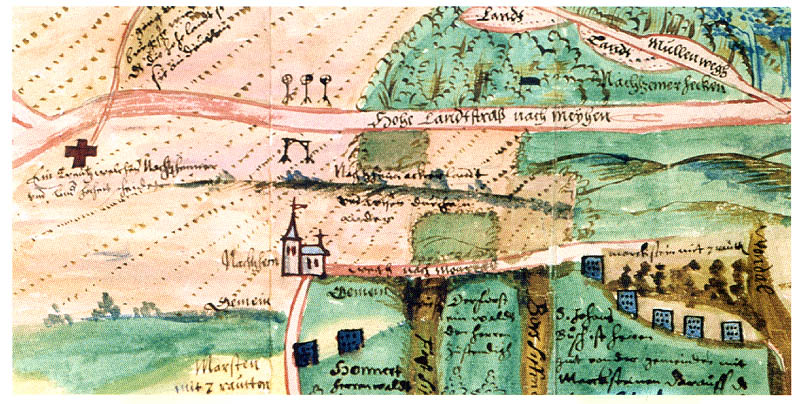 Peasants as Demonologists
Peasants as Demonologists
I. Persecutions in the Archbishopric of Trier
Image: Johann VII von Schönenberg, Prince-Archbishop of Trier (1581-1599)
Image: Karl Kaspar von der Leyen, Prince-Archbishop of Trier (1652-1676)
Map: The Prince-Archbishopric of Trier, 1600
Map: Investigations of
Four Witch Committees
Map: The Holy Roman Empire, 1648
II. Pitfalls of "Functionalism"
A) Were Witches Always Marginal?
B) "Projection" and the Problem of Possessed Accusers
C) Adolescent Anxiety?
III. Witchcraft and the Power of Suggestion

Image above: A detail from a seventeenth-century map, showing the location
of an execution site between the villages of Nachtsheim and Virneburg, near
Mayen, in the Archbishopric of Trier; Landeshauptarchiv Koblenz. Image source: Zauberei- und Hexenprozesse
im Maas-Rhein-Moselraum 15.-17. Jahrhundert. Image right: a broadsheet illustration from the trial of Joan
Prentice (or Prentis) in 1589. According to the pamphlet, Joan lived in the almshouse at Sible Hedingham, and confessed that she had a familiar in the shape of a ferret named Satan. She tried to resist his overtures, but let him suck her blood and then used him to harm her neighbours. She said that the ferret disobeyed her instructions to hurt a child and instead killed it, but this excuse did not save her from execution. Prentice was hanged at Chelmsford on 5 July 1589. She named two other women, Elizabeth Whale and Elizabeth Mott, whom she said used the same spirit, but they were discharged without trial
Source: Oxford Dictionary of National Biography.